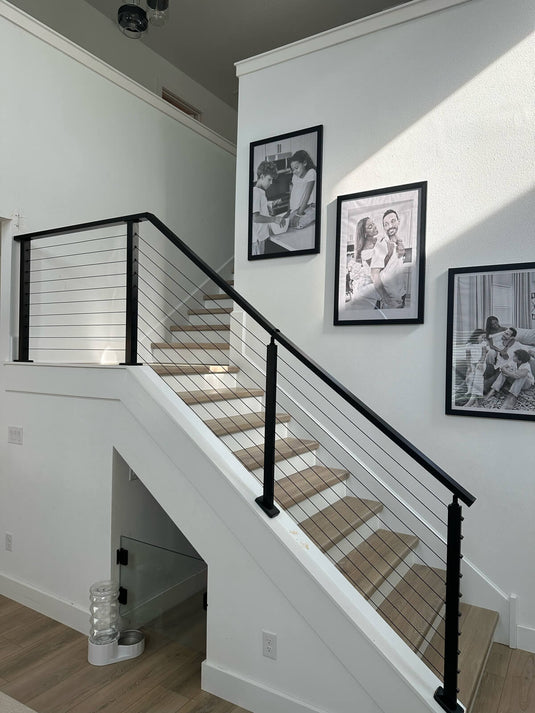TABLE OF CONTENTS
Aluminum Railing for Decks: The Ultimate Guide in 2024
Aluminum railings are quickly becoming a highly popular option for decking projects. As every homeowner knows, deck railings take a beating from weather, kids, pets, and everyday wear and tear. Aluminum is lightweight for easier installation, while also being extraordinarily strong and durable. When powder coated, aluminum resists rust, peeling, and cracking and never needs painting. Today's aluminum deck railings are available in a variety of aesthetic styles – from sleek cabling to modern glass infills. This guide will overview the unbeatable benefits of aluminum deck railings, factors to consider when selecting your system, proper installation, and the newest innovations that make aluminum the best choice in safety, functionality, and beauty for your deck.

Benefits of Aluminum Deck Railings
Selecting the ideal deck railings is a crucial part of designing your outdoor space. Aluminum deck railings are known for their blend of functionality and aesthetic appeal, making them a top pick for homeowners. Let’s explore the practical benefits that make aluminum railings a wise choice for any decking project.
Low Maintenance
●Aluminum railings don't splinter or crack like wood can over time.
●They maintain their appearance without needing paint or stain, thanks to a powder coating that resists rust and corrosion.
●Cleaning is straightforward – a simple soap and water mix will do the job.
●They withstand weather effects, such as fading or the buildup of dirt and mildew, with minimal upkeep required.
Durability
●These railings are resilient against UV damage and harsh weather conditions, maintaining their structure and look over the years.
●They have strong post mounts and brackets designed to stay secure, even when faced with strong winds or heavy usage.
Safety
●Aluminum railings are constructed to conform to International Building Code requirements, ensuring safety for elevated areas and stairways.
●With options to customize the spacing between cables or pickets, they provide a barrier that is safe for children and pets while still allowing clear views.
Aluminum railings offer an unmatched combination of low maintenance, lasting durability, and reliable safety for your decking area. They are not only functional but also complement the aesthetics of your outdoor living space. As you consider the practicalities of your deck design, remember that aluminum railings present a solid, long-term investment in both the safety and enjoyment of your home.

How to Choose the Right Aluminum Railings
With so many styles, brands, and customization options available, selecting the perfect aluminum railing system may seem daunting. Keep these key considerations in mind:
Height
●Verify local building codes for height requirements.
●Standard railing heights are typically 36 inches for residential and 42 inches for commercial settings.
●Measure deck elevation from the ground to ensure compliance and proper fit.
Mounting Style
●Top mount railings attach to the top of the deck surface and are typically easier for maintenance.
●Side mount railings connect to the side of the deck, offering a cleaner line of sight.
Infills
●Cable infills maximize visibility and provide a modern look.
●Glass panels create a wind barrier and offer a sleek aesthetic.
●Balusters and pickets are traditional options that can range from simple to ornate.
Weight Load
●Choose railings rated for appropriate weight loads; 125 pounds per square foot in vertical pressure is standard, with 200 pounds for lateral force.
●For high-traffic or public areas, consider railings with higher weight capacity ratings.
Matching Décor
●Select colors and finishes that complement or contrast with your home’s exterior and outdoor furniture.
●Consider whether you want your railings to be a standout feature or to integrate subtly with your space.
Picking the right aluminum railings involves balancing style with substance, ensuring they not only enhance your deck's look but also meet safety standards and integrate smoothly with your home’s architecture. With these factors in mind, you'll be well on your way to selecting a railing system that brings lasting value and appeal to your outdoor living area.

Installing Aluminum Railings
When it comes to installing your new aluminum railing system, you have two options – hiring a professional or opting for a DIY project.
Professional Installation
Experienced deck builders and railing installation pros can expertly handle the entire job from precise measuring to custom fabrication of posts and rails to finished mounting. This ensures correct building code compliance, safety, and aesthetically pleasing results. Hiring pros adds to the project cost but can provide peace of mind.
DIY Installation
Ambitious and skilled DIYers can tackle aluminum railing installations on their own. The process involves securing sturdy mounting hardware and brackets to your deck substructure, attaching bottom and top railing posts per the manufacturer’s instructions, inserting any infill panels or mesh, and then adding decorative post caps. Precision measuring is key, as is drilling accurate pilot holes before fastening.
Most reputable aluminum railing companies provide detailed installation manuals and instructional videos. Some even offer Zoom or over-the-phone guidance. Budget plenty of time and patience – complex railings with curves, angles, and glass panels prove especially tricky for amateur installers.Inspect your new railings to ensure a sound, wobble-free structure that meets local safety codes. Most building codes require professional inspection, especially for second-story and non-ground-level decks.
Choose Aluminum Railings for Durability & Style in 2024
Aluminum railings are a top choice for residential decks, balconies, stairways, and porches. They combine enviable beauty, ultra-low maintenance, long life, and reasonable affordability. Their high strength-to-weight ratio also eases installation complexity. When planning your dream outdoor living space, aluminum deck railings contribute an ideal blend of form and function. After reviewing the benefits, customization capabilities, and newest innovations covered in this guide, the reasons to select durable, reliable aluminum railings are clear. Specify the optimal height, mounting method, and infill material and soon you’ll be enjoying your new low-maintenance, safe outdoor retreat!
Q&A
Q1: Are aluminum deck railings expensive?
A: Aluminum deck railings are considered a mid-range option when it comes to cost. They are generally more affordable than wrought iron or steel and can be less expensive in the long term compared to wood, due to lower maintenance costs. While they may have a higher upfront price than some materials like vinyl, their durability, and longevity can make them a cost-effective choice over time.
Q2: How long do aluminum deck railings last?
A: Aluminum deck railings are known for their long-lasting qualities, often outlasting the decks to which they are attached. With proper installation and minimal maintenance, they can last for decades. Their resistance to rust, corrosion, and weather-related damage contributes significantly to their lifespan.
Q3: What is better aluminum or vinyl railings?
A: Whether aluminum or vinyl railings are better depends on your specific needs and preferences. Aluminum railings are typically stronger and more durable than vinyl, offering better structural support and resistance to impact. Vinyl railings, however, do not require painting and resist staining. In terms of maintenance, both are low-maintenance, but aluminum can handle harsher conditions without sustaining damage. For overall strength and durability, aluminum often has the advantage; for cost and ease of installation, vinyl might be preferable.
Q4: How much does aluminum deck railing cost per foot?
A: The cost per linear foot for aluminum deck railings can vary widely depending on factors such as the complexity of the design, the quality of the material, and regional pricing variations. On average, you can expect to pay anywhere from $40 to $70 per linear foot for materials and installation of standard aluminum railings. Customized options or additional features like integrated lighting or premium finishes can increase the cost. Always get multiple quotes from suppliers to ensure competitive pricing for your specific project.




